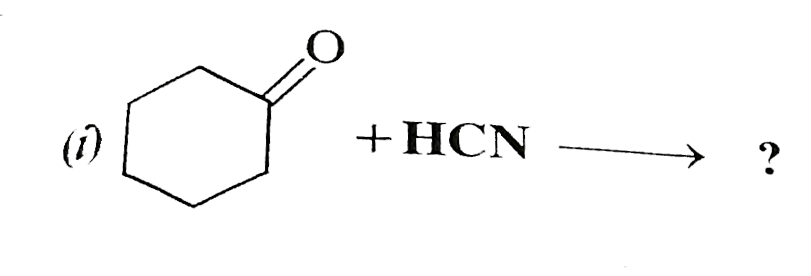R−C≡N1.DIBAL−−−−−→2.H2O
To solve the problem of what product is formed when R-C≡N (an alkyl cyanide) is treated with DIBAL (Diisobutyl Aluminium Hydride) followed by hydrolysis with water, we can follow these steps:
Step 1: Identify the Reactants
- The reactant is an alkyl cyanide, which has the structure R-C≡N. Here, R represents an alkyl group, and C≡N represents the cyanide functional group.
Hint: Recognize the structure of alkyl cyanides and their functional groups.
Step 2: Understand the Role of DIBAL
- DIBAL is a strong reducing agent. It is used to reduce nitriles (like alkyl cyanides) to imines. The reaction involves the addition of hydrogen to the carbon atom of the cyanide group.
Hint: Recall that DIBAL is a reducing agent that can convert nitriles to imines.
Step 3: Reaction with DIBAL
- When R-C≡N reacts with DIBAL, the carbon atom of the cyanide group (C≡N) becomes bonded to DIBAL, forming an intermediate. The nitrogen atom will acquire a positive charge, and a bond will form between the carbon and the aluminum from DIBAL.
Hint: Visualize the formation of an intermediate where the nitrogen is positively charged and bonded to aluminum.
Step 4: Formation of an Imine
- The intermediate formed will rearrange, leading to the formation of an imine (R-C=N-Al). The triple bond between carbon and nitrogen converts to a double bond, and the aluminum will be neutralized in the process.
Hint: Remember that the reduction process leads to the formation of an imine from the nitrile.
Step 5: Hydrolysis with Water
- The next step involves hydrolysis with water. During hydrolysis, the C=N bond in the imine will react with water, leading to the cleavage of the bond and the formation of an aldehyde (R-C-H-O).
Hint: Hydrolysis typically involves the addition of water to break bonds and form new functional groups.
Step 6: Final Product
- The final product after hydrolysis is RCHO, which is an aldehyde.
Hint: Recognize that the product of hydrolysis of the imine is an aldehyde.
Conclusion
The overall reaction of R-C≡N with DIBAL followed by hydrolysis with water yields RCHO, an aldehyde.
Final Answer
The product is RCHO (an aldehyde).
---
- The reactant is an alkyl cyanide, which has the structure R-C≡N. Here, R represents an alkyl group, and C≡N represents the cyanide functional group.
- DIBAL is a strong reducing agent. It is used to reduce nitriles (like alkyl cyanides) to imines. The reaction involves the addition of hydrogen to the carbon atom of the cyanide group.
- When R-C≡N reacts with DIBAL, the carbon atom of the cyanide group (C≡N) becomes bonded to DIBAL, forming an intermediate. The nitrogen atom will acquire a positive charge, and a bond will form between the carbon and the aluminum from DIBAL.
- The intermediate formed will rearrange, leading to the formation of an imine (R-C=N-Al). The triple bond between carbon and nitrogen converts to a double bond, and the aluminum will be neutralized in the process.
- The next step involves hydrolysis with water. During hydrolysis, the C=N bond in the imine will react with water, leading to the cleavage of the bond and the formation of an aldehyde (R-C-H-O).
- The final product after hydrolysis is RCHO, which is an aldehyde.
The overall reaction of R-C≡N with DIBAL followed by hydrolysis with water yields RCHO, an aldehyde.
The product is RCHO (an aldehyde).
Similar Questions
Knowledge Check
R−O∣∣C−ClNH3−−→NH4Cl+(X)P4O10−−−→Δ(Y)(i)DIBAL−H−−−−−−−−−→(ii)H2O(Z)
The compound (Z) isAR-COOHBR−CH2−OHCR−C≡NDRCHOR−CN(i)DIBAL−H−−−−−−−−−→(ii)H2OR−Y
Consider the above reaction and identify YA−CH2NH2B−CONH2C−CHOD−COOHConsider the following reaction :
C6H5−CH3∣C∣H(R)−Cl+C2H5⊕O→C2H5O−CH3∣C∣H100%(S)form−C5H5
In the given
C6H5−⋅⋅S⋅⋅−CH2−H∣C∣CH3−Br+C2H5⊕O→(P) the product is :AC6H5−⋅⋅S⋅⋅−CH2(S)−H∣C∣CH3−OHBHO−H∣C∣CH3(S)−CH2(R)−S−C5H5CC6H5−⋅⋅S⋅⋅−CH2(S)−H∣C∣CH3−OC2H5DC2H5O−H∣C∣CH3(S)−CH2−S−C6H5
HOCH2CH2CH2−O∣∣C−OCH2CH3PCC−−→(A)H2C=CHMgBr−−−−−−−−−−−−−→(1molar equivalent)(B)NH4Cl/H2O−−−−−−−→(C)KOH−−−−−→H2OH3O⊕−−−→⎛⎜ ⎜ ⎜⎝CH3−O∣∣C⎞⎟ ⎟ ⎟⎠2O−−−−−−−−−−−−→Pyridine(D)
Product (D) is :
View SolutionCH3CH2−O∣∣C−O−C2H2(i)DIBAL.H(1eq)−−−−−−−−−−−−→(ii)H3O+A+B A and B are respectively.
View SolutionThe correct stability order of the following resonanating structures is :
CH2=C=O(I) C3−C−+C=O(II) H2C=+C−−O(III) H2−C−C≡+O(IV)
View SolutionC6H5NHO∣∣C−CH3(1)H+OH−−−−−−−−−→(2)H2OA, A is
View SolutionThe end product (B) of the reaction sequence:
C2H5−N∣H−CH3Ph−O∣∣C−Cl−−−−−−→NaOHALiAlH4−−−→H2OB
View Solution

